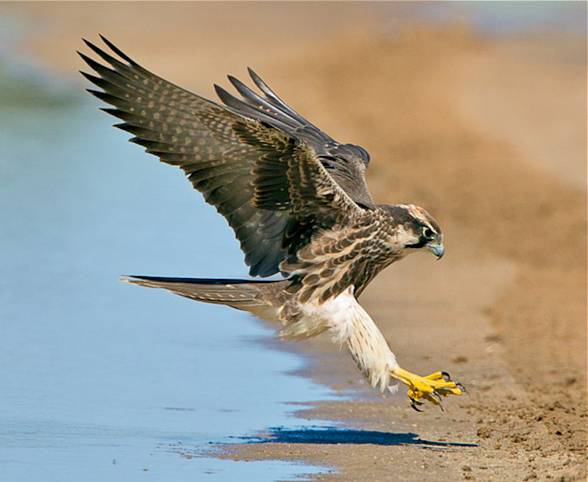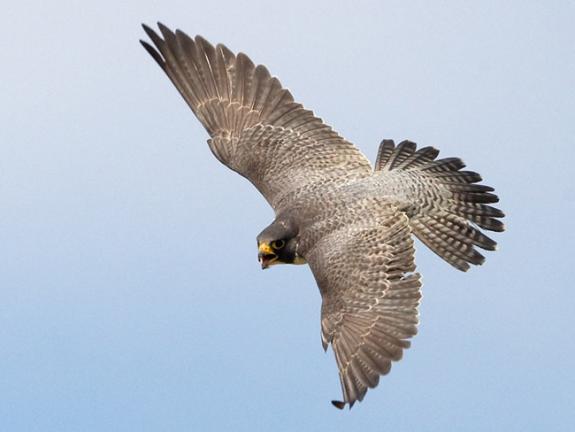
Peregrine Falcon has a top speed of 242 mph, marking it the fastest living creature on earth.
Peregrine falcon speed free#
But doubling the mass, say the difference between a male and a female can change this as well.Įdit: that should be 280 kilometers per hour not per second. The only major ice free land mass from which it is entirely absent is New Zealand. The average peregrine falcon weighs from 1 to 3.5 pounds (0.4 to 1.6 kilograms), has a wingspan of 31 to 48 inches (79 to 122 centimeters) and an average body length of 13 to 20 inches (33 to 51 centimeters). The terminal velocity is not so sensitive to the mass of the bird as it enters the formula as a square root.

One can see that decreasing the radius of the bird even to 8 cm increases the terminal velocity by quite a bit, easily pushing it past 200 miles/h. These ferocious birds of prey perch atop high tree branches while looking for their prey. While swooping, or dropping down on prey, they have reached speeds as high as 238 mph. Just the cursing speed of Peregrine Falcon’s averages between 24-33 mph. This expression is normalized to r=10 cm radius for the bird's cross section and m=0.5 kg. These magnificent birds fly as fast as 67 mph while chasing their prey. I assumed the falcon had a radius of 5cm based on pictures and knowing the length. The cross sectional area was just a guess. The Peregrine Falcon is one of the most widespread birds in the world. During its spectacular hunting stoop from heights of over 1 km (0.62 mi), the peregrine may reach speeds of 320 km/h (200 mph) as it drops toward its prey. I used a mass of 0.5 kg, though this is on the small end, and used the drag coefficient of a streamlined body from the sidebar. The Peregrine Falcon is a very fast flier, averaging 40-55 km/h (25-34 mph) in traveling flight, and reaching speeds up to 112 km/h (69 mph) in direct pursuit of prey. This spring, the same male falcon mated with a different female falcon, and they. The peregrine is the fastest bird on record reaching horizontal cruising speeds of 65-90 kph ( 40-55 mph) and not exceeding speeds of 105-110 kph (65-68 mph). It's not that tough to calculate, but are some approximations that must be made. A lone chick took flight at Harpers Ferry for the first time in 70 years. Limited by availability of nest sites and prey thus, it often moves into cities, nesting on building ledges and feeding on pigeons.The formula for the terminal velocity is given here. It can fly at a speed of 68 miles per hour, and it can dive through the air at an even more amazing. Often near water, especially along coast, and migrants may fly far out to sea. The peregrine falcon is the fastest animal in the world. Over its wide range, found in wide variety of open habitats, from tundra to desert mountains. Peregrines nest between August and November with females usually laying two to three eggs (rarely four). Open country, cliffs (mountains to coast) sometimes cities. Peregrine falcons are not only the fastest bird in the world, reaching speeds of up to 180km per hour (some estimates even have them flying at much greater speeds) but they are also one of the most agile aerial hunters. Current populations appear to be stable or increasing. The peregrine falcon is best known for its diving speed during flightwhich can reach more than 300 km (186 miles) per hourmaking it not only the world’s fastest bird but also the world’s fastest animal. Has been reintroduced in many temperate areas in North America, and Arctic nesting populations have recovered somewhat also. The Peregrine Falcon is the most well known bird in falconry, which involves training birds of prey to use for hunting. The peregrine falcon can measures from 14 to 19 inches (36 to 49 cm) with a wingspan ranging from 3.3 to 3.6 feet (100 to 110 cm).

Conservation statusĬoncentrations of pesticides from its prey caused widespread failure to reproduce during 1940s-1970s, and species disappeared from much of former breeding range. According to an experiment done in 2005 by Ken Franklin, the speed of the falcon reaches a value of 242 mph which is the fastest speed ever observed till now. Their best-known hunting technique is the stoop, a steep dive from as high. Although it is found on six continents, the Peregrine is uncommon in most areas it was seriously endangered in the mid-20th century because of the effects of DDT and other persistent pesticides. Peregrine Falcons hunt from high in the air above land or water.

Regarded by falconers and biologists alike as one of the noblest and most spectacular of all birds of prey. One of the world's fastest birds in power-diving from great heights to strike prey, the Peregrine may possibly reach 200 miles per hour.


 0 kommentar(er)
0 kommentar(er)
